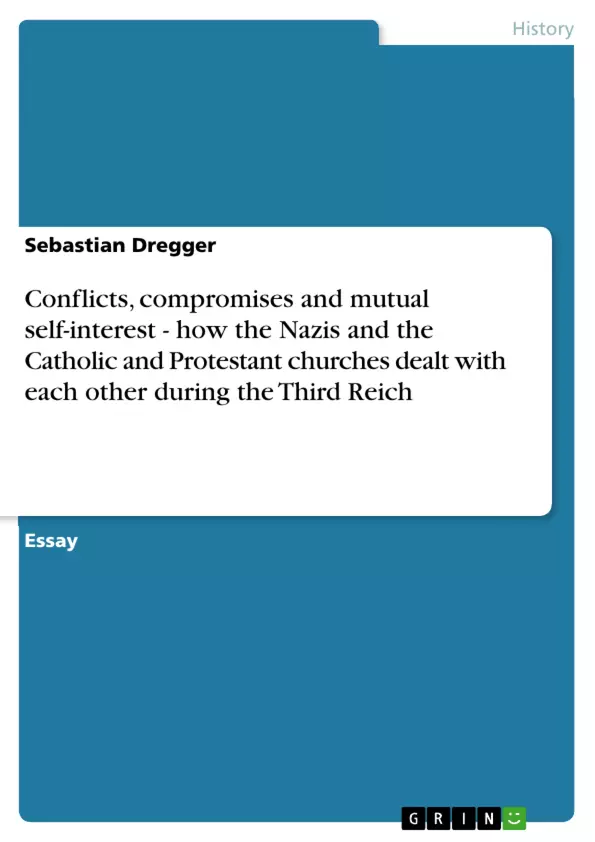Free from any apologetic or debunking fuss, the essay depicts the complex relationship between the Nazi state and the Catholic and Protestant Churches during the Third Reich. Focussing on three major areas of conflict between the Churches and the Nazis(sychronization ('Gleichschaltung'), the Nazis' anti-church policies, the churches and euthanasia) the essay's argument is that a pragmatic approach by both Churches and the Nazis based on the preservation of mutual self-interest is the key to understand their dealing with each other in each individual case of conflict. In a second part, the essays seeks to explain why both protagonists preferred a pragmatic instead of a more radical and uncompromising approach to each other, stating that three factors are accountable for this: First, mutually shared political views based on anti-liberalism and anti-Marxism; second, a tremendous mispercerption of the regime's nature by both churches; third, the limits of anti-church policies among a population still being deeply Christianized.
Table of Contents
- I. Introduction
- II. Areas of conflict
- A. The Churches facing the regime's synchronization policy
- 1. The Protestant Church
- 2. The Catholic Church
- B. Deliberate anti church measures against the Catholic Church
- 1. Goebbels' '‘Moral Trials'.
- 2. Bormann's dissolution of the monasteries.
- C. Ecclesiastical protest against racial excesses..
- 1. The papal encyclical “With burning anxiety”.
- 2. Protest against ‘Euthanasia’
- A. The Churches facing the regime's synchronization policy
- III. Reasons for the 'pragmatic approach'.
- IV. Conclusion
Objectives and Key Themes
This essay examines the complex relationship between the Nazi regime and the Protestant and Catholic Churches during the Third Reich. The paper focuses on analyzing how both sides dealt with conflict through a pragmatic approach. The essay explores key areas of conflict, including the regime's synchronization policy, anti-church measures, and ecclesiastical protest against racial policies. The key themes explored in the essay are:- The interplay of conflict and compromise between the Nazi regime and the churches.
- The churches' willingness to consider the Nazi regime as the legitimate government, despite disagreements.
- The Nazi regime's tolerance of the churches as legitimate social institutions with some autonomy.
- The factors that contributed to the pragmatic approach, including shared political views, misperception of the regime's nature, and the limitations of anti-church policies.
Chapter Summaries
I. Introduction
This chapter introduces the three main areas of conflict between the Nazi regime and the Protestant and Catholic Churches: the integration of churches during the synchronization policy, anti-church measures, and church criticism of racial policies. It sets forth the argument that a pragmatic approach characterized the interactions between the Nazi state and the churches, emphasizing compromise, mutual recognition, and limited autonomy for the churches.II. Areas of conflict
This chapter details the areas of conflict between the Nazi regime and the churches.A. The Churches facing the regime's synchronization policy
This section examines the churches' response to the synchronization policy, which aimed to integrate all public institutions into the Nazi regime.1. The Protestant Church
This subsection analyzes the conflicts that arose within the Protestant Church, particularly concerning the establishment of a unified and nazified Reich Church, the incorporation of the 'Aryan Paragraph', and the purging of 'Jewish elements' from the Gospel.2. The Catholic Church
This subsection examines the Catholic Church's response to the synchronization policy, highlighting the conflicts that arose and the challenges they faced in maintaining autonomy.B. Deliberate anti church measures against the Catholic Church
This section explores the specific anti-church measures implemented by the Nazi regime against the Catholic Church, including Goebbels' 'Moral Trials' and Bormann's dissolution of monasteries.C. Ecclesiastical protest against racial excesses..
This section focuses on the churches' resistance to specific racial policies, such as the papal encyclical "With Burning Anxiety" and protests against the 'Euthanasia' program.III. Reasons for the 'pragmatic approach'.
This chapter explores the reasons behind the pragmatic approach adopted by both the Nazi regime and the churches, identifying factors like shared political views, misperception of the regime's nature, and the limitations of anti-church policies.Keywords
This essay examines the dynamic relationship between the Nazi regime and the Protestant and Catholic Churches during the Third Reich. The key terms that define the relationship include synchronization policy, Gleichschaltung, anti-church measures, 'Aryan Paragraph', 'Moral Trials', 'Euthanasia', and the Confessing Church. The essay focuses on the pragmatic approach adopted by both sides, highlighting factors like compromise, mutual self-interest, and limited autonomy.- Citar trabajo
- Sebastian Dregger (Autor), 2008, Conflicts, compromises and mutual self-interest - how the Nazis and the Catholic and Protestant churches dealt with each other during the Third Reich, Múnich, GRIN Verlag, https://www.grin.com/document/112682



